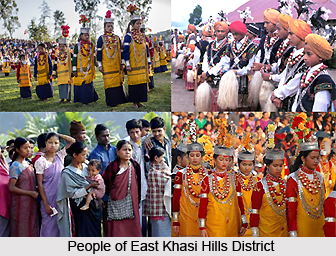 People of East Khasi Hills District constitute of the Khasi, Jaintia , Bhoi tribes who are collectively known as the Hynniewtrep people and they predominantly inhabit the district of East Khasi Hills, also known to be one of the earliest ethnic groups of settlers in the Indian sub-continent, belonging to the Proto Austroloid Monkhamer race. Khasis occupying the northern lowlands and foothills are generally called Bhois and those who live in the southern tracts are termed Wars. The common language spoken is the Khasi language and owing to the demands of globalization English as a colonial tongue is also being used by the educated masses as well as for official communications.
People of East Khasi Hills District constitute of the Khasi, Jaintia , Bhoi tribes who are collectively known as the Hynniewtrep people and they predominantly inhabit the district of East Khasi Hills, also known to be one of the earliest ethnic groups of settlers in the Indian sub-continent, belonging to the Proto Austroloid Monkhamer race. Khasis occupying the northern lowlands and foothills are generally called Bhois and those who live in the southern tracts are termed Wars. The common language spoken is the Khasi language and owing to the demands of globalization English as a colonial tongue is also being used by the educated masses as well as for official communications.
Costumes of East Khasi Hills District
The traditional Khasi male dress is `Jymphong` or a longish sleeveless coat without collar; fastened by thongs in front though as per the demands of time the Khasis have adopted the western dress. On ceremonial occasions, they appear in `Jymphong` and dhoti with an ornamental waist-band. Khasi traditional female dress is rather elaborate with several pieces of cloth, giving the body a cylindrical shape. On ceremonial occasions, they wear a crown of silver or gold on the head. A spike or peak is fixed to the back of the crown, corresponding to the feathers worn by the men folk. The Khasi lady wears a dress called `Jainsem` which flows loose to the ankles. The upper part of her body is clad in a blouse. Over these, she ties both ends of a chequered cotton cloth on one shoulder, thus improvising on apron. On formal occasions, worn over the `Jympien` is a long piece of Assam Muga silk called `Ka Jainsem Dhara` which hangs loose below the knees after being knotted or pinned at the shoulders. The `Tapmohkhlieh` or head-shawl is either worn by knotting both ends behind the neck or is arranged in a stylish manner as done with a shawl. The jewellery of the Khasis and the Jaintias are also alike and the pendant is called `Kynjri Ksiar`, being made of 24 carat gold. The Khasis and the Jaintias also wear a string of thick red coral beads round their neck called `Paila during festive occasions.
Foods in East Khasi Hills District
The staple food of Khasis is rice and they also into non vegetarian food. Like the other tribes in the North-East, the Khasis also ferment rice-beer, and make spirit out of rice or millets by distillation. Use of rice-beer is a must for every ceremonial and religious occasion.
Marriage System in East Khasi Hills District
The Khasis have a matrilineal society. Descent is traced through the mother, but the father plays an important role in the material and mental life of the family.
In the Khasi society, the woman looks after home and hearth, the man finds the means to support the family, and the maternal uncle settles all social and religious matters.
Khasis follow a matrilineal system of inheritance. In the Khasi society, it is only the youngest daughter or `Ka Khadduh` who is eligible to inherit the ancestral property.
If `Ka Khadduh` dies without any daughter surviving her, her next elder sister inherits the ancestral property, and after her, the youngest daughter of that sister. Failing all daughters and their female issues, the property goes back to the mother`s sister, mother`s sister`s daughter and so on. The Ka Haddon`s property is actually the ancestral property and so if she wants to dispose it off, she must obtain consent and approval of the uncles and brothers. Among the War-Khasis, however property passes to the children, male or female, in equal shares.
When it comes to marriage, the nuptial knot within a clan is a taboo. Rings or betel-nut bags are exchanged between the bride and the bridegroom to complete the union. In the Christian families, however, marriage is purely a civil contract. The Khasis are now mostly Christians. But before that, they believed in a Supreme Being, The Creator - U Blei Nongthaw and under Him, there were several deities of water and of mountains and also of other natural objects. The three major tribes of Meghalaya have distinct costumes and jewellery. However, with the change of time as in the rest of the country, the males have adopted the western code of dress leaving the ladies to continue the tradition of ethnic sartorial elegance.
Education in East Khasi Hills District
The history of formal education in Meghalaya in general and in East Khasi Hills District in particular has been a recent one commencing with the formulation of a Khasi Alphabet in 1842 by Mr. Thomas Jones, a Welsh missionary.
The first college was established in Shillong only in 1924 by the Christian Brothers of Ireland. Being a hill station blessed with bracing weather and having a strong colonial influence, several quality colleges and Public schools have been established over the years. Also several National Institutes of repute like the North Eastern Hill University which is a Central University, The North Eastern Indira Gandhi Regional Institute of Health & Medical Science (NEIGRIMS), the Indian Institute of Management (IIM), National Institute of Fashion Design (NIFT), Indian Institute of Hotel Management, Central Institute of English & Foreign Languages(CIEFL) and various other Prominent Institutes of Higher Learning have since then been set up at Shillong, the district headquarter.



















